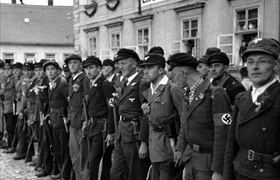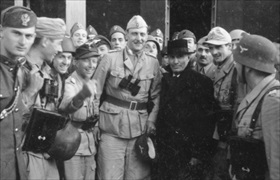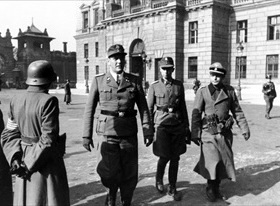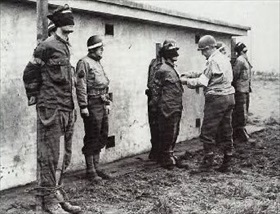GERMANS CREATE NUCLEUS OF BRANDENBURGER COMMANDOS
Berlin, Germany • October 15, 1939
On this date in 1939 Adm. Wilhelm Canaris, head of the German Abwehr (military intelligence), directed Capt. Theodor von Hippel to raise a commando unit that would become known by year’s end as the Brandenburgers. The name derived from the unit’s training site, Brandenburg on the Havel, roughly 54 miles/87 km east of the German capital, Berlin. The idea for the formation of this special forces unit came from Hippel himself when he outlined the role of a unit able “to seize vital objects such as bridges, tunnels, crossroads and armaments plants and hold them until the arrival of the leading units of the German Armed Forces.” Located in the Abwehr’s Department II, which handled all sabotage actions and special missions carried out by the Abwehr, the unit’s cover name was the 800th Special Construction Training Company (later Battalion). The unit’s ancestry dated to a company of mostly civilian volunteers (Freikorps): one from Sudetendeutsches Freikorps (Sudeten German Freikorps, residents of German-speaking Czechoslovakia) and one from Freikorps Ebbinghaus named for its commander. The two companies were the creation of separate Abwehr stations in Dresden and Breslau (today Wrocław, Poland), respectively. The volunteers were given limited Abwehr training for special use in the September 1939 invasion of Poland.
Elite units like the Brandenburgers required professional soldiers and extremely well-trained fighters. Chief among the Brandenburgers’ tasks were covert special operations often behind enemy lines: reconnaissance, raids, sabotage, seizing strategic targets (e.g., road and railway bridges, tunnels, road crossings, and sea locks), supporting pro-Axis guerrillas in the enemy hinterland, conducting counterinsurgency operations against Allied partisans or nationalist insurgents in German-occupied or -aligned states, and other types of irregular warfare. Contrary to customary international law, commandos’ disguises sometimes included dressing partially or entirely in their opponent’s uniforms or in civilian clothes. Many Brandenburgers were former mountain troops or Germans who were born or had lived aboard and knew the language and way of life in their deployment areas. Many were simply ardent National Socialists (Nazis) who had served in one of the Freikorps in the 1930s.
Brandenburgers were deployed in small groups, never as an entire entity until shortly before the end of the war when their organization was reclassified as a conventional Panzergrenadier division in the German Wehrmacht (armed forces). At that point, many Brandenburgers transferred to Otto Skorzeny’s SS-Jagdverbaende (SS hunting associations; see photo essays below). For most of their career Brandenburgers were subordinated to army groups in individual commands. Their field of covert operations included Western and Central Europe, Italy after Germany’s Axis ally had switched to the Allied side in October 1943, the Balkans, North Africa, the Middle East, the Soviet Union, and Afghanistan. In some areas of operations the Brandenburgers and similar German special forces acquired well-deserved reputations for acting with ruthless efficiency against their enemies—combatants and civilians alike—often committing war crimes according to current views.
German Special Operations Forces, 1938–1945. Focus on Otto Skorzeny (1908–1975)
 |  |
Left: This photo shows members of the paramilitary Sudetendeutsches Freikorps (aka Freikorps Henlein) on October 10, 1938, in Niemes (Czech, Mimoň), Sudetenland in the Liberec region of today’s Czech Republic (Czechia). The lineup of men took place less than 2 weeks after the principal European statesmen had awarded the German-speaking Czech borderlands to Germany in the wake of the infamous Munich Agreement of September 30, 1938. The Sudetendeutsches Freikorps was controlled by far-right Sudeten German leader Konrad Henlein and his pro-Nazi Sudeten German Party. Henlein openly pushed to join Sudetenland to Germany. On October 1, 1938, Adolf Hitler appointed a grateful Henlein Reichskommissar of the incorporated Sudeten territories. That same month Henlein disbanded his Freikorps. Many ex-members joined various Nazi organizations. Some joined Freikorps Ebbinghaus, which took part in the 1939 invasion of Poland, and some joined the Brandenburger special forces.
![]()
Right: Not all unconventional German warfare was conducted by the Abwehr’s Brandenburgers. The Abwehr had a fierce competitor. Hitler’s Nazi Party’s SS (Schutzstaffel) had formed a paramilitary unit called SS-Sonderverband z.b.V. Friedenthal (the initials z.b.V. indicated special duties). The unit was commanded by Hauptsturmfuehrer (Captain) Otto Skorzeny, a self-promoter if there ever was one. In this photo, Skorzeny (center, dangling binoculars) stands with the liberated Italian dictator Benito Mussolini, September 12, 1943. Neither a planner of Mussolini’s rescue nor its leader, Skorzeny (who had discovered Mussolini’s whereabouts), along with 15 of his SS commandos, accompanied dozens of German paratroopers (Fallschirmjaeger) to the Gran Sosso’s Hotel Campo Imperatore high up in the Apennine mountains, where the deposed Italian dictator was held captive. Skorzeny prudently invited several war correspondents to record the historic raid. The high-risk Operation Eiche (Oak) saved Mussolini by one day from being turned over to the Allies under the terms of the Long Armistice. At the same time it catapulted the derring-do SS-commando leader to worldwide fame. Besides a promotion to Sturmbannfuehrer (major), Hitler awarded Skorzeny the Knight’s Cross of the Iron Cross and sent him, as a token of his personal gratitude for rescuing Mussolini, a signed enamel-and-gold cigarette case crafted in a Nazi concentration camp and a solid-gold death’s head SS ring. Skorzeny used the honors to grab more headlines and more fame later in Hungary and in the Ardennes Offensive (Battle of the Bulge).
 |  |
Left: SS-Sturmbannfuehrer Skorzeny (left) and ex-Brandenburger Adrian von Foelkersam (middle) with Skorzeny’s SS-Jaeger-Battalion 502 (formerly Sonderverband z.b.V. Friedenthal) on Castle Hill, the government district in Hungary’s capital, Budapest, October 16, 1944. Picked for having famously snatched Axis ally Benito Mussolini from his Italian captors the year before, Hitler entrusted Skorzeny with kidnapping Miklós (“Miki”) Horthy, Jr. Operation Panzerfaust (aka Operation Micki Maus, October 15–16, 1944) was intended to force Horthy Jr.’s father to abdicate as Hungary’s head of state following that country’s preliminary armistice with Germany’s enemy, the Soviet Union, on October 11. (Horthy Sr. abdicated in exchange for his son’s life.) Skorzeny took father and son back to Germany, where the senior Horthy lived under round-the-clock SS guard until freed by elements of Lt. Gen. Alexander Patch’s U.S. Seventh Army. The younger Horthy survived his imprisonment at Dachau concentration camp. The two Horthys went into exile in Portugal after the war.
![]()
Right: Skorzeny was Hitler’s choice to head Operation Greif, the Fuehrer’s own brainchild that involved planting German special forces personnel behind Allied lines during the Ardennes Offensive, aka Battle of the Bulge (December 16, 1944, to January 25, 1945). Specially trained soldiers from Skorzeny’s SS-Panzer Brigade 150 (the latest reincarnation of his special forces) were to conceal themselves in U.S. and British army uniforms, carry and drive Allied equipment, and be familiar with the enemy’s language and customs. Besides tasked with capturing bridges, they were to sow disruption and disinformation behind Allied lines. On December 19, 1944, three of Skorzeny’s Trojan horse commandos were captured behind U.S. lines in American uniforms. The three—Sgt. Manfred Pernass, Sgt. Guenther Billing, and Lance Cpl. Wilhelm Schmidt—were given a military trial 2 days later, found guilty of espionage, and, as seen in this photo, bound to posts and executed by firing squad on December 23. Over the next 3 weeks 13 more of Skorzeny’s commandos were caught and executed. Skorzeny and 8 officers of his panzer brigade were tried as war criminals at the postwar Dachau Trials for allegedly breaching the international laws of war (Hague Land Warfare Regulations). A U.S. military tribunal acquitted all defendants after a covert agent testified that he and his operatives wore German uniforms behind enemy lines while working for the British Special Operations Executive.
Hitler’s Elite Special Forces: The Brandenburger Commandos
![]()

 History buffs, there is good news! The Daily Chronicles of World War II is now available as an ebook for $4.99 on Amazon.com. Containing a year’s worth of dated entries from this website, the ebook brings the story of this tumultuous era to life in a compelling, authoritative, and succinct manner. Featuring inventive navigation aids, the ebook enables readers to instantly move forward or backward by month and date to different dated entries. Simple and elegant! Click
History buffs, there is good news! The Daily Chronicles of World War II is now available as an ebook for $4.99 on Amazon.com. Containing a year’s worth of dated entries from this website, the ebook brings the story of this tumultuous era to life in a compelling, authoritative, and succinct manner. Featuring inventive navigation aids, the ebook enables readers to instantly move forward or backward by month and date to different dated entries. Simple and elegant! Click 











